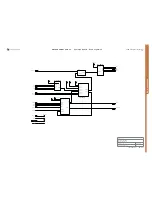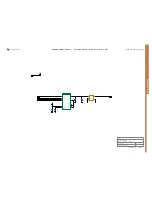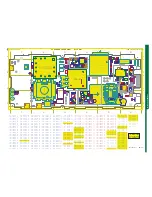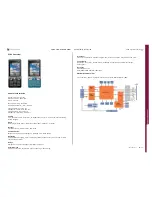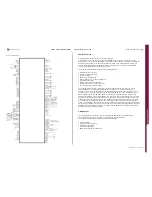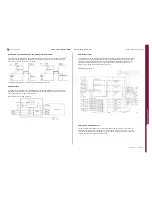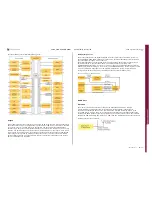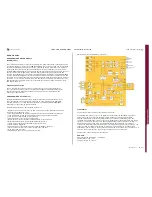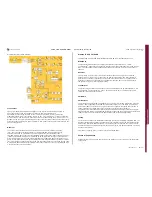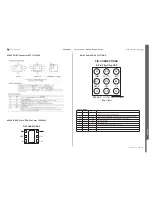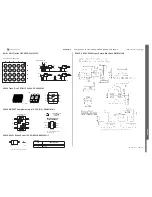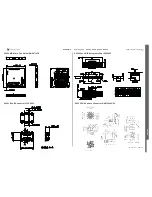
C702
1221-7857 rev. 1
FUNCTIONAL OVERVIEW
FU
N
C
T
IO
N
A
L O
V
E
R
V
IE
W
Technical Description
GSM 900:
Frequency Range: 890,2 MHZ – 914,8 MHZ
Channel Range: 1 - 124
Power Level: Min 19 – Max 5
EGSM 900:
Frequency Range: 880,2 MHZ – 889,8 MHZ
Channel Range: 975 - 1023
Power Level: Min 19 – Max 5
DCS 1800:
Frequency Range: 1710,2 MHZ – 1784,8 MHZ
Channel Range: 512 – 885
Power Level: Min 15 – Max 0
PCS 1900:
Frequency Range: 1850,2 MHZ – 1909,8 MHZ
Channel Range: 512 - 810
Power Level: Min 15 – Max 0
Receiver
The receiver is a homodyne receiver with direct conversion of the received radio channel
to baseband I and Q channels. The analog signals are converted to digital bit streams in a
sigma delta A/D converter. The receiver block consists of a front-end with separate LNAs for
each band and a common quadrature mixer. The front-end block is followed by a baseband
block with active antialiasing filters that also suppress blocking signals and interferers. After the
baseband block is a fully integrated Analog to Digital Converter of sigma delta structure with
high dynamic range. The digital output signals are sent over a serial interface to the digital
base-band circuit for further processing and detection.
RX Frequency and Channel Range
GSM 850:
Frequency Range: 869,2 MHZ – 893,8 MHZ
Channel Range: 128 – 251
GSM 900:
Frequency Range: 935,2 MHZ – 959,8 MHZ
Channel Range: 1 - 124
EGSM 900:
Frequency Range: 925,2 MHZ – 934,8 MHZ
Channel Range: 975 – 1023
DCS 1800:
Frequency Range: 1805,2 MHZ – 1879,8 MHZ
Channel Range: 512 – 885
PCS 1900:
Frequency Range: 1930,2 MHZ – 1989,8 MHZ
Channel Range: 512 - 810
WCDMA Radio Module
N1210 (Squid)
In WCDMA the differential transmit outputs from the WCDMA transceiver are filtered by an
external SAW filter. The SAW filter cleans up the spectrum and also provides a single ended
drive signal to the power amplifier. For power control, a sample of the transmit output is taken
by a directional coupler and converted to a DC level by the power detection circuit. This signal
is used to control the transmitter output power. The transmit signal passes through an isolator
and then a duplexer. The duplexer output is selected by a switch in the N1200 (Thor) module
for connection to the antenna. In WCDMA receive mode the signal from the antenna is switched
by the duplexer inside N1200 module (Thor). The output from the duplexer is amplified by one
of the low noise amplifiers in the LNA/SAW module, then filtered by an integrated receive SAW
filter. The SAW filter converts the unbalanced receive signal to a differential signal required by
the WCDMA receiver. The N1200 (Thor) module supplies the N1210 (Squid) module with a 26
MHz clock (WBCLK) and the antenna switch functionality. The module is shielded using fence
and lid technology.
Frequency Generation
The transmitter and receiver frequency synthesizers and the VCOs are fully integrated in
the WCDMA radio circuit. The signal from the crystal oscillator is used as a reference for
the synthesizers. The two synthesizers are controlled through the serial bus from the
access subsystem of the digital baseband controller.
WCDMA Transceiver
The WCDMA transceiver uses differential analog in-phase and quadrature-phase
Interfaces; that is, an IQ-interface, both in the receiver and transmitter information path.
The receiver part of the transceiver consists of an RF front end, a channel filter, and
Automatic Gain Control (AGC), and the transmitter part consists of an analog voltage
baseband I and Q interface, an up mixer and an RF VGA. Each part has an RF VCO and
an RF fractional-N synthesizer PLL. All functions are controlled by a 3-wire serial
programmable bus.
WCDMA BAND I is covered by Squid Module.
Band I (TX Frequency Range: 1920 – 1980 MHz, RX Frequency Range: 2110 – 2170 MHz)
SEMC Troubleshooting Manual
92
(115)
Summary of Contents for C702
Page 116: ...www s manuals com ...


